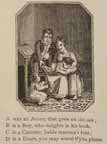 lthough hornbooks predate alphabet books as the oldest Roman letter teaching device, alphabet books were often used as a reading supplement in tandem with hornbooks, and by the mid-nineteenth century, had largely replaced hornbooks in English nurseries. The rise of alphabet books in sixteenth-century Europe closely follows the rise of Protestantism in countries such as Germany and England. This is no coincidence, for the Protestant stress upon individual interpretations of the Bible naturally required a literate parish.
lthough hornbooks predate alphabet books as the oldest Roman letter teaching device, alphabet books were often used as a reading supplement in tandem with hornbooks, and by the mid-nineteenth century, had largely replaced hornbooks in English nurseries. The rise of alphabet books in sixteenth-century Europe closely follows the rise of Protestantism in countries such as Germany and England. This is no coincidence, for the Protestant stress upon individual interpretations of the Bible naturally required a literate parish.
Early alphabet books aimed primarily to enable their readers to read the Bible and other moral tracts. In fact, the alphabet was generally regarded as the first step to learning words, phrases, and stories that in turn would teach social and religious concepts. (Demers 83) Indeed, early tracts combined the alphabet with religious texts such as the Paternoster (Our Father) or the Ten Commandments. (Joosen 3)
Even as subsequent generations of alphabet books gained illustrations and more attractive text, they continued to present a strongly moral tone for their young readers. In fact, William Ronskley's The Child's Weeks-Work published in 1712 presented the letters A and B in the rhyme: "All do, my Dear, as you see here/ Be sure you pray both Night and Day." (Joosen 4) Another example is apparent in Henry Dixon's 1760 The English Instructor, a rhyme presented here for children to copy and memorize consists of the lines:
Abstain from all Appearance of Evil. By the Truth, and sell it not. Cease, my Son, to hear the Instruction that causeth to err. Do not render Evil for Evil unto any Man.
These rather grim cautionary alphabets continue on into the next century. The Good Child's Reward published in 1815 presents as its final rhymes:
W stands for wicked, Which if you should be, You must be whipped, And that would grieve me.
X stands for the cross, On which Christ died in pain; How great was his loss! But still greater our gain.
Y stands for the young, Such as your are, my dear, Who should keep a still tongue, And be willing to hear.
These last three verses serve to illustrate the moral and religious imperative that continue to frame the context of alphabet books even in the nineteenth century. Furthermore, the use of "you" and "me" highlights the youthful audience whom the author admonishes to be "still" and "willing to hear." Children then, should learn their letters and be properly fearful of wickedness and whippings.


Left: An alphabet book published by Banbury. Right: A detail from the previous image showing parents reading to a young child. [Click on the thumbnails for larger images.]
At the same time, by the turn of the century the new emphasis on enjoyable instruction increasingly shaped alphabet books. An early example of this chnage appears in the 1764 The Renowned History of Giles Gingerbread, where Gaffer Gingerbread feeds young Giles letters made of gingerbread, thereby slyly playing with the book's final epithet, "Giles Gingerbread, he lov'd Cream, Custard and Curds,/ And Good Books so well, that he eat up his Words" (30). This chapbook attributed to John Newbery, intersperses lessons on the alphabet and morality in an entertaining tale of Giles Gingerbread's own enlightenment which begins with his father's admonishment, "Think of this, my Dear Giles, and learn your Book, and say your Prayers, and go to Church and be honest and good, and industrious, that you may get a Coach also." (14) Giles does eventually get to ride on Sir Toby's wonderful Coach, after he has learnt his alphabet beginning with "Ay, mr. A, I shall know you again, Apple for that." and ending with "Z, is a Zany, and a Zany's a Fool,/ Who don't love his Book, or his Master, or School" (21) as well as lessons such as "How to be Happy and go to Heaven" followed by a host of cautionary tales.
Nineteenth-century publishers continued to create increasingly pleasing and playful contributions to the growing field of children's literature. Benjamin Collins aptly illustrates this new trend away from grim morality to pleasurable learning in selling alphabet games consisting of paper squares with letters on them by the middle of the century. (Joosen 4) Finally, alphabet books that enjoyed immense popularity in the nineteenth century include Edward Lear's 1846 Book of Nonsense and Walter Crane's 1874 Absurd ABC.
Related Material
- Four nonsense alphabets by Edward Lear (Project Gutenberg text prepared by Dave Newman, Ben Courtney, A. Deubelbeiss, and Stan Goodman)
- Punch's "Nursery Education Report" — a Parody of ABC Books
Bibliography
Demers, Patricia. Heaven upon Earth: the form of moral and religious children's literature, to 1850. Knoxville: University of Tennessee Press, 1993.
Joosen, Vanessa. "ABC Books" The Oxford Encyclopedia of Children's Literature. Vol. 1. Jack Zipes, editor-in-chief. Oxford and New York: Oxford University Pres, 2006.
Pearson, Edwin. Banbury Chap Books and Nursery Toy Book Literature.. London: Arthur Reader, 1890.
The Renowned History of Giles Gingerbread, A Little Boy who lived upon Learning. Attributed to John Newbery. The First Worcester Edition. Worcester, Massachusetts. Isaiah Thomas, 1786.
Last modified 1 August 2007